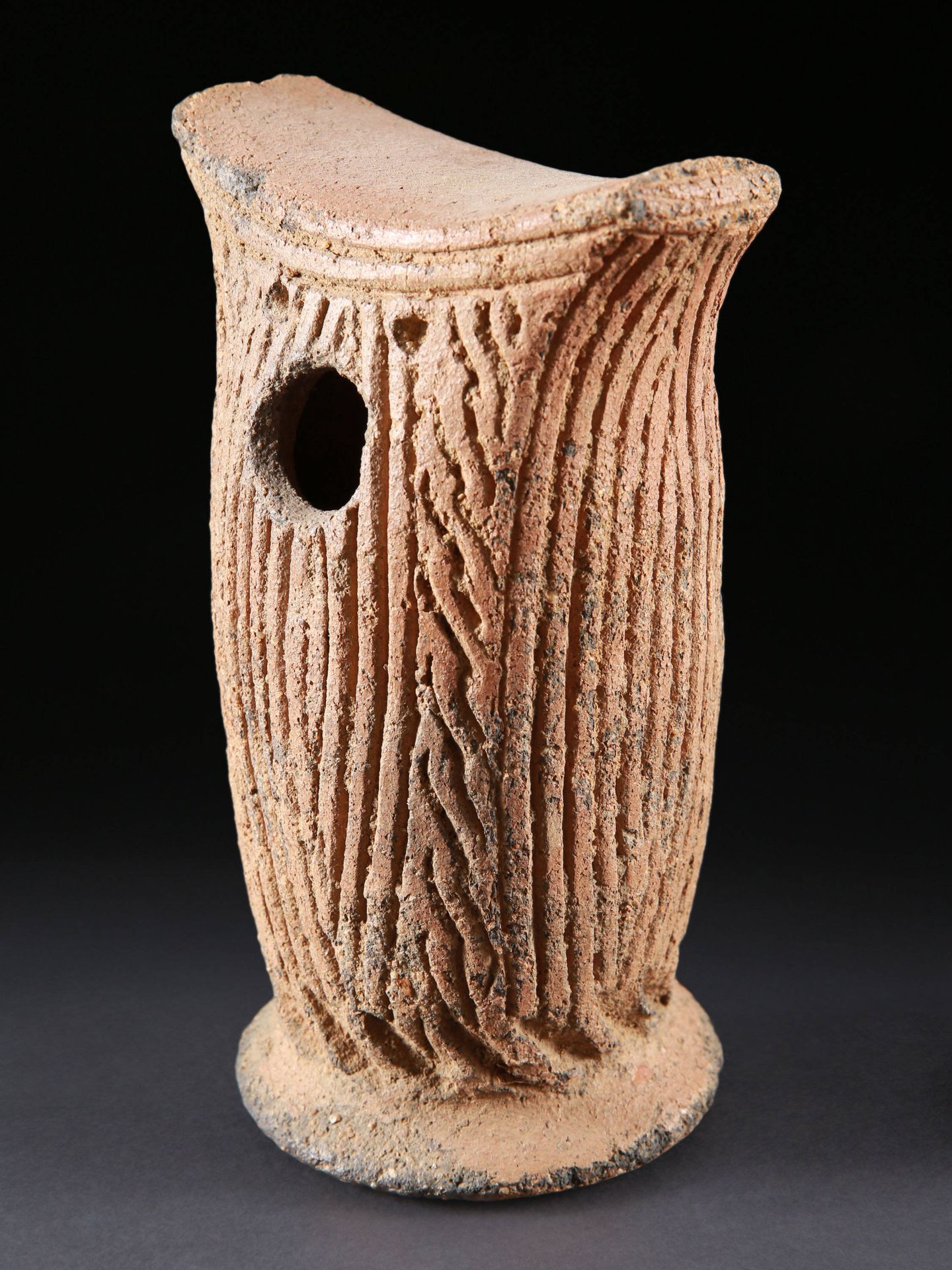Description
A Calabar "Headrest" "Neck support" Calabar, Nigeria Ohne Sockel / without base Terracotta. H 18 cm. Provenance: Galerie Walu, Zurich (before 1996). Thermoluminescence age determination: 400 years (+/- 20 %). At the end of the 16th century, followers of various ethnic groups from Cameroon (Qua) and Nigeria (Efut and Efik) settled in the area of present-day Calabar along the estuaries, where traditional markets and trade flourished alongside agriculture and fishing. However, archaeological excavations from the 1970s indicate that the area was probably already inhabited in the 5th century. Richly decorated terracotta objects (dating back to the 11th century) feature geometric motifs and wickerwork patterns as well as images of pre-coinage currency. Presumably created by women, according to Gitti Salami (2008), the symbolism used reflects important cultural events as well as the everyday life of the creators and / or owners. Further reading: Gitti (Salami), "Les terres cuites anciennes Calabar au Nigeria", in: Morin, Floriane / Wastiau, Boris (2008). African Terrcottas. A Millenary Heritage. Barbier-Mueller Museum Collections. Geneva: Musée Barbier-Mueller. CHF 200 / 400 Condition: Visible knocks (see photos). Visible knocks (see photos). -------------------------------- The condition (wear, eventual cracks, tear, other imperfections and the effects of aging etc. if applicable) of this lot is as visible on the multiple photos we have uploaded for your documentation. Please feel free to contact Hammer Auktionen for all questions you might have regarding this lot ([email protected]). Any condition statement given, as a courtesy to a client, is only an opinion and should not be treated as a statement of fact. Hammer Auctions shall have no responsibility for any error or omission. In the rare event that the item did not conform to the lot description in the sale, Hammer Auktionen is here to help. Buyers may return the item for a full refund provided you notify Hammer Auktionen within 5 days of receiving the item. -------------------------------------------- The condition (possible wear, signs of use, cracks, possible other damage and signs of age, etc.) of this lot can be seen in the photos we have uploaded for your documentation. If you have any questions about this item, please do not hesitate to contact Hammer Auctions ([email protected]). The information regarding the condition of the items provided for the convenience of interested parties is an opinion only and should not be treated as a statement of fact. Hammer Auctions accepts no responsibility for any errors or omissions. In the rare event that the item does not match the description in the catalog, Hammer Auctions is here to help. Buyers may return the lot for a full refund provided they notify Hammer Auctions within 5 days of receiving the lot.
39
A Calabar "Headrest" "Neck support" Calabar, Nigeria Ohne Sockel / without base Terracotta. H 18 cm. Provenance: Galerie Walu, Zurich (before 1996). Thermoluminescence age determination: 400 years (+/- 20 %). At the end of the 16th century, followers of various ethnic groups from Cameroon (Qua) and Nigeria (Efut and Efik) settled in the area of present-day Calabar along the estuaries, where traditional markets and trade flourished alongside agriculture and fishing. However, archaeological excavations from the 1970s indicate that the area was probably already inhabited in the 5th century. Richly decorated terracotta objects (dating back to the 11th century) feature geometric motifs and wickerwork patterns as well as images of pre-coinage currency. Presumably created by women, according to Gitti Salami (2008), the symbolism used reflects important cultural events as well as the everyday life of the creators and / or owners. Further reading: Gitti (Salami), "Les terres cuites anciennes Calabar au Nigeria", in: Morin, Floriane / Wastiau, Boris (2008). African Terrcottas. A Millenary Heritage. Barbier-Mueller Museum Collections. Geneva: Musée Barbier-Mueller. CHF 200 / 400 Condition: Visible knocks (see photos). Visible knocks (see photos). -------------------------------- The condition (wear, eventual cracks, tear, other imperfections and the effects of aging etc. if applicable) of this lot is as visible on the multiple photos we have uploaded for your documentation. Please feel free to contact Hammer Auktionen for all questions you might have regarding this lot ([email protected]). Any condition statement given, as a courtesy to a client, is only an opinion and should not be treated as a statement of fact. Hammer Auctions shall have no responsibility for any error or omission. In the rare event that the item did not conform to the lot description in the sale, Hammer Auktionen is here to help. Buyers may return the item for a full refund provided you notify Hammer Auktionen within 5 days of receiving the item. -------------------------------------------- The condition (possible wear, signs of use, cracks, possible other damage and signs of age, etc.) of this lot can be seen in the photos we have uploaded for your documentation. If you have any questions about this item, please do not hesitate to contact Hammer Auctions ([email protected]). The information regarding the condition of the items provided for the convenience of interested parties is an opinion only and should not be treated as a statement of fact. Hammer Auctions accepts no responsibility for any errors or omissions. In the rare event that the item does not match the description in the catalog, Hammer Auctions is here to help. Buyers may return the lot for a full refund provided they notify Hammer Auctions within 5 days of receiving the lot.
You may also like
